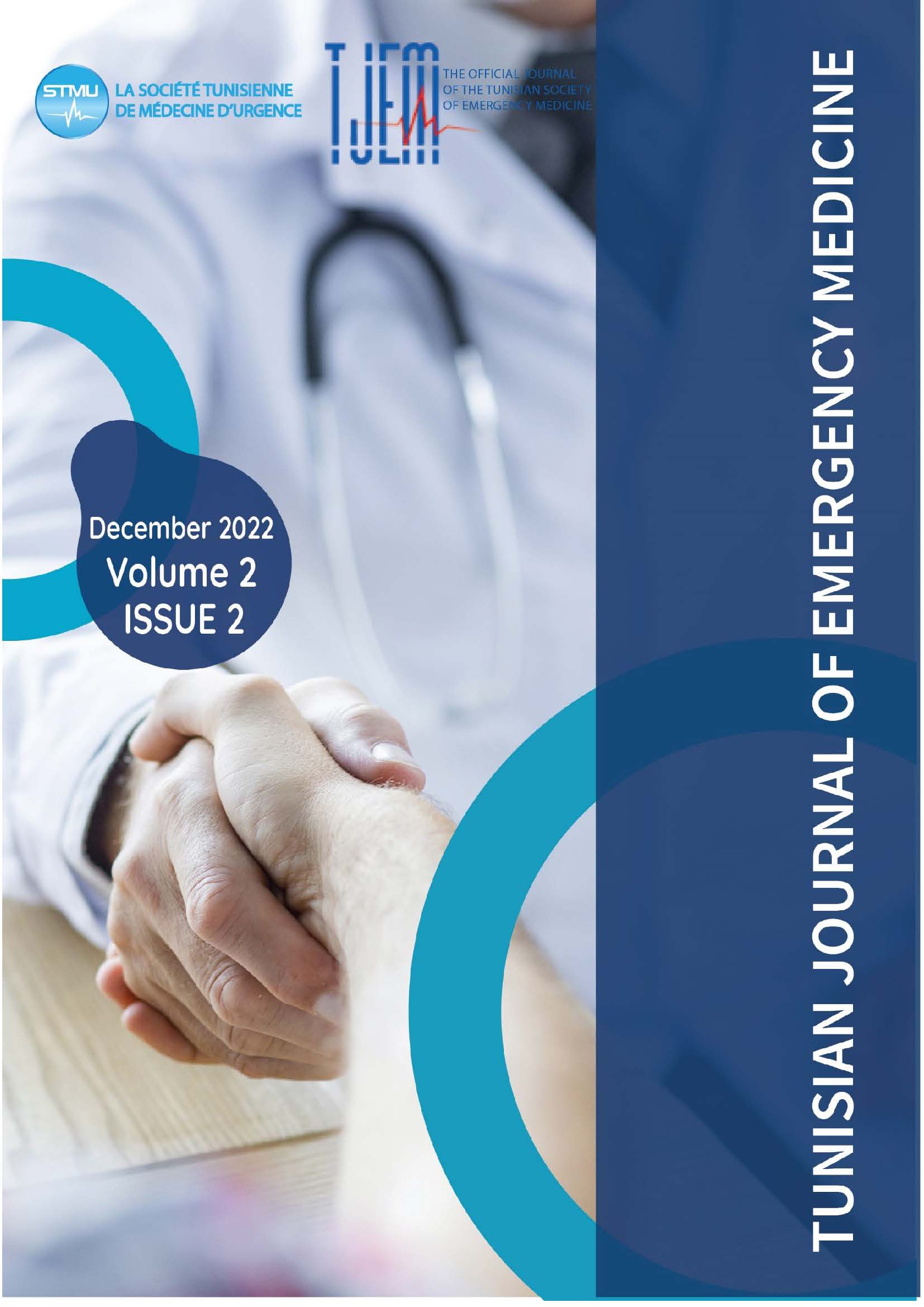A new practical score for early diagnosis of appendicitis in the emergency department
Rahma JABALLAH; Hajer YAAKOUBI; Lotfi BOUKADIDA; Rym YOUSSEF; R KADDACHI; H BEN SALAH; Asma ZORGATI; Riadh BOUKEF
DOI:
https://doi.org/10.0000/wt7kg606Keywords:
Appendicitis, Emergency department, Clinical Score, Predictive FactorsAbstract
Background: Acute abdominal pain is the most common complaint encountered in the emergency department. Appendicle pathology, the most frequent cause of this acute abdominal pain, can be extremely challenging to identify, requiring laboratory testing, and layered diagnostic imaging. In this case, clinical scoring systems can be helpful.
The purpose of this study is to develop and validate a new predictive score based on clinical and laboratory variables that can help the physician to identify patients at high or low risk for appendicitis in the emergency department.
Materials and methods: This study was designed as a prospective one-year study from January to December 2017 and included 200 patients older than 16 years admitted to the emergency department with abdominal pain indicating acute appendicitis. The final diagnosis of acute appendicitis was provided by the specific examination of the surgical specimen. Statistical analysis was performed using SPSS version 21. A score was derived from a multiple regression analysis. The ROC curve was obtained from which the appropriate cut-off value was identified for dichotomization.
Results: There were 200 patients enrolled in this study divided into two groups: 97 were diagnosed with of 7 variables: WBC count > 10,000 (2 points), tenderness in RLQ (2 points), migration of pain from the epigastrium to the RLQ (2 points), a positive Blumberg sign (1 point), a positive Rovsing sign (1 point), a sensible abdomen (2
The discrimination power of the constructed score was good (area under the receiver operating characteristic curve= .937), even better than the Alvarado score (area under the ROC curve=.887). Our score performed well (P = .88). The score has good sensitivity and negative predictive value at a cutoff value of 4.
Conclusion: bio-clinical scores can be used as a basis for a structured algorithm for the management of patients consulting for abdominal pain, several scores have been developed (Alvarado, Andersson, François ...) but this is not common practice. In this study, we have developed a new clinical-biological predictive score (SAAS score) for acute appendicitis which is practical and easy but it remains to be validated in external centers.
Downloads
Published
Issue
Section
License
Copyright (c) 2022 Tunisian Journal of Emergency Medicine

This work is licensed under a Creative Commons Attribution-NonCommercial-ShareAlike 4.0 International License.
How to Cite
Similar Articles
- mahmoud ladhar, Chourouk Frikha, Manel Feki, Mouna Loukil, Faiza Safi, Mortality in Pediatric Intensive Care , Tunisian Journal of Emergency Medicine: Vol. 3 No. 2 (2025): TJEM 2025: Vol.3 Issue 2
- Wiem Feki, Fatma Hammami, Amina Kammoun, Makram Koubaa, Zaineb Mnif, Vascular causes of pediatric acute ischemic stroke: the crucial role of imaging , Tunisian Journal of Emergency Medicine: Vol. 3 No. 2 (2025): TJEM 2025: Vol.3 Issue 2
- Fatma Hbaieb, Low Back Pain Revealing Bilateral ProximalPulmonary Embolism with COVID-19 , Tunisian Journal of Emergency Medicine: Vol. 2 No. 4 (2024): TJEM Vol2 Issue4
- Faten DHOUIB, Aimen Dammak, Faiza Safi, Fatma MHIRI, zied CHAARI, Successful Conservative Management of Penetrating Cervical Tracheal Injury: A Case Report , Tunisian Journal of Emergency Medicine: Vol. 3 No. 1 (2025): TJEM 2025: Vol.3 Issue 1
- Randa dhaoui, Khaoula bel Haj Ali, Adel Sekma, Sarra Sassi , Wahid Bouida, semir nouira, The challenge in diagnosing human rabies: A case report , Tunisian Journal of Emergency Medicine: Vol. 3 No. 1 (2025): TJEM 2025: Vol.3 Issue 1
- safia othmani, Ischemic acute cholecystitis: a case report , Tunisian Journal of Emergency Medicine: Vol. 2 No. 4 (2024): TJEM Vol2 Issue4
- Dr.Rania AMMAR ZAYANI, Dr.Sarra Temani, Dr. Mabrouk Bahloul, Dr.Chokri Ben Hamida, Pregabalin Toxicity-Induced Posterior Reversible Encephalopathy Syndrome , Tunisian Journal of Emergency Medicine: Vol. 3 No. 2 (2025): TJEM 2025: Vol.3 Issue 2
- Wiem Feki, Fatma Hammami, Amina Kammoun, Makram Koubaa, Mounir Ben Jemaa, Zaineb Mnif, Emphysematous pyelonephritis with infected abdominal aorta pseudoaneurysm among a diabetic man , Tunisian Journal of Emergency Medicine: Vol. 3 No. 2 (2025): TJEM 2025: Vol.3 Issue 2
- Neila MAAROUFI, Youssef Zouaghi, Khaoula Amdouni, Sabra Ouaz, Beligh Oueslati, Moufida Nouari, Beyond the Rash: The Fatal Consequences of Lyell Syndrome , Tunisian Journal of Emergency Medicine: Vol. 3 No. 2 (2025): TJEM 2025: Vol.3 Issue 2
- Rania Hammami, Syrine Triki, Aimen Dammak, Faiza Safi, Olfa Chakroun , An abrupt cardiogenic shock in a female at the era of COVID 19 pandemic lockdown , Tunisian Journal of Emergency Medicine: Vol. 3 No. 1 (2025): TJEM 2025: Vol.3 Issue 1
You may also start an advanced similarity search for this article.

